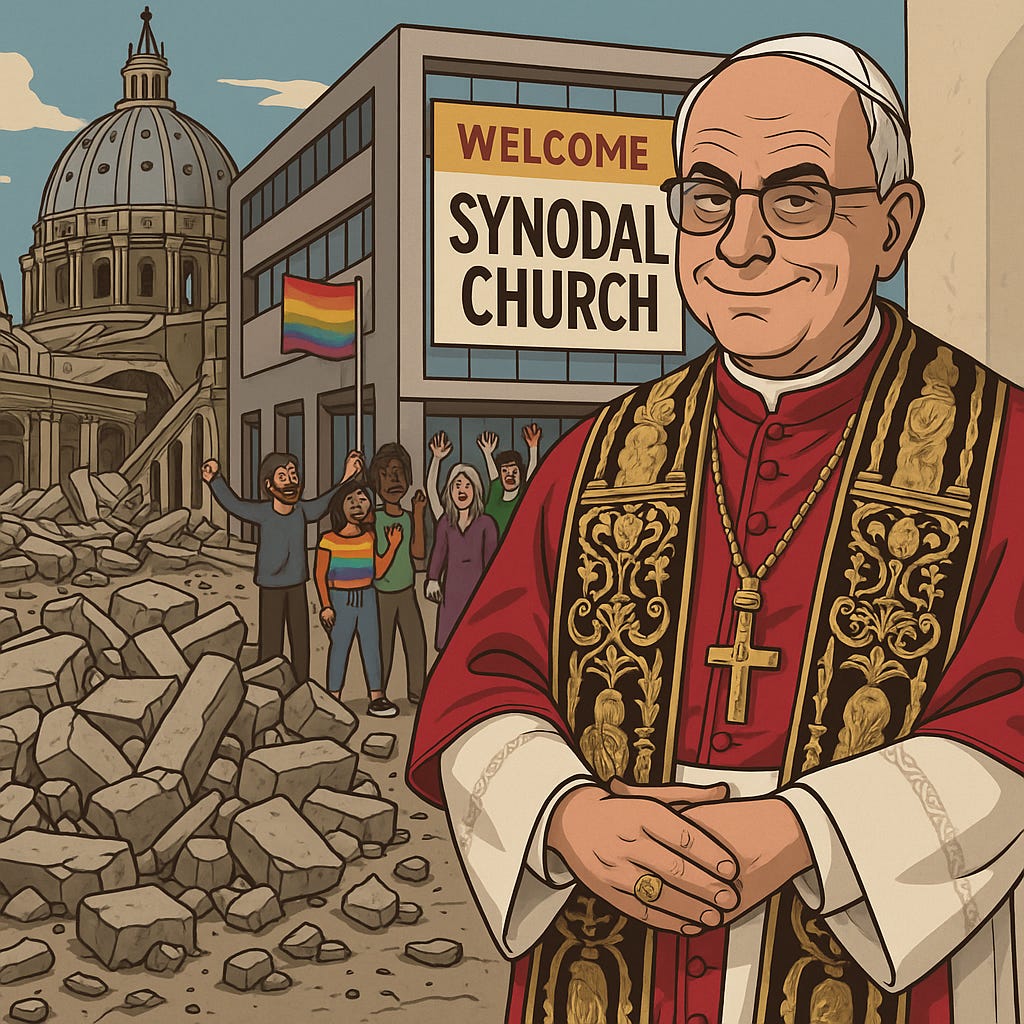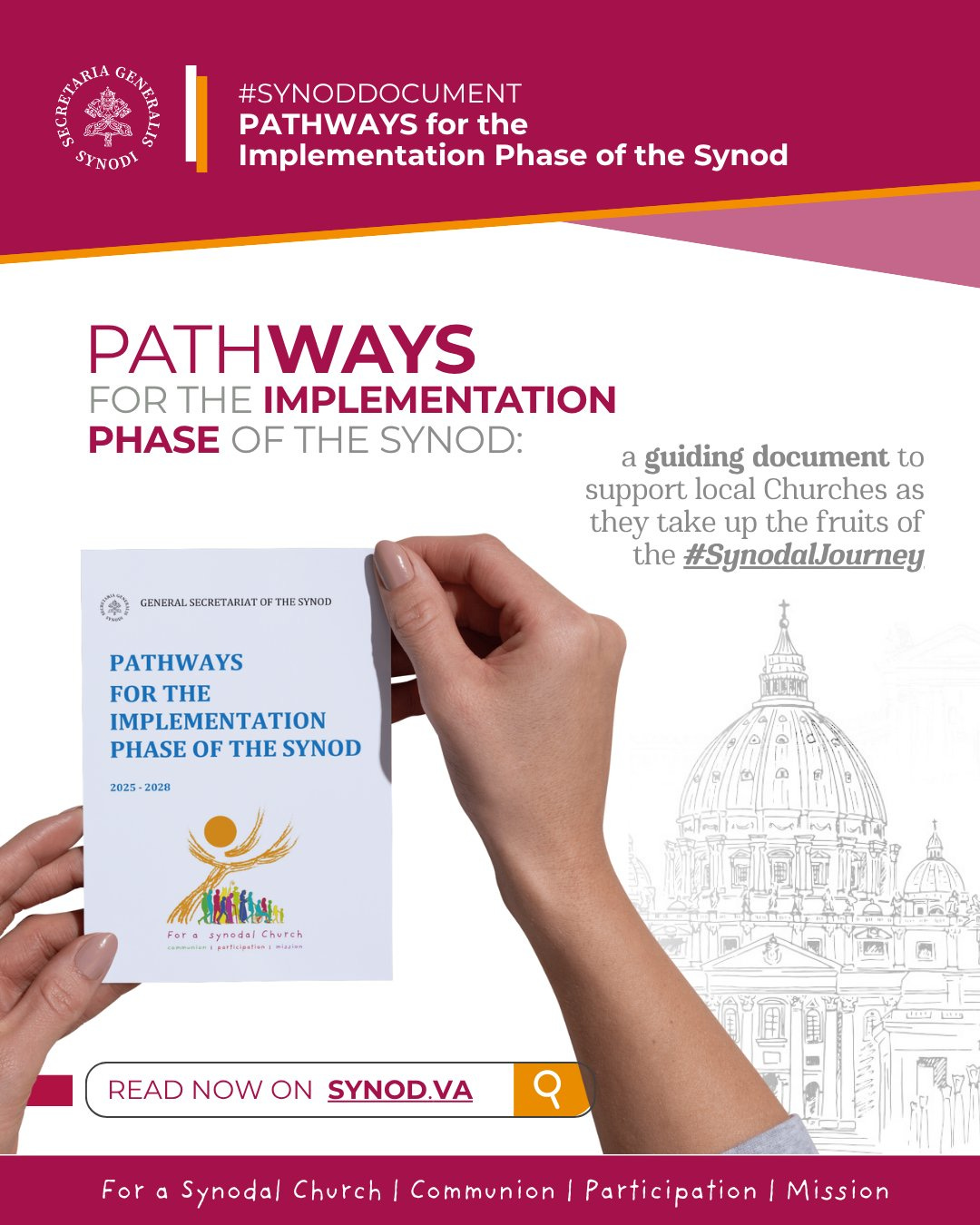Catholics! Are You Ready for Your New, Permanent, Synodal Church? Leo Is.
The Synod’s Final Phase Isn’t Implementation, It’s Institutionalization
When Leo XIV was elected on May 8, 2025, some voices in Trad Inc. whispered that this was our chance for a course correction. The chaos of Francis, they said, might be smoothed by a more disciplined successor. “He’s a liturgy guy,” they claimed. “He might pull things back from the brink.”
Two months later, July 7, the Vatican released Pathways for the Implementation Phase of the Synod, a 14-page roadmap outlining the next three years of synodal transformation. If anything, the “reform of the Church” that began under Francis is not just continuing, it’s accelerating, institutionalizing, and being codified into the very DNA of the postconciliar Church. The theology behind this isn’t new. It’s the same populist anthropocentrism that shaped Jorge Mario Bergoglio in Buenos Aires, the so-called “theology of the people,” now rebranded and globalized as the final phase of synodal implementation.
What Trad Inc. promised would be a reset is turning out to be a reinforcement.
The Language of Revolution, the Tone of Bureaucracy
The new Pathways document is, on its surface, bland and managerial. Full of phrases like “shared frameworks,” “evaluation pathways,” and “local adaptation,” it cloaks its intentions in committee-speak. But make no mistake: this is not a mere organizational plan. It is, in the Vatican’s own words, a “new way of being Church.”
That phrase alone should trigger alarms.
Throughout the document, phrases like “discernment,” “dialogue,” “listening,” and “accompaniment” are deployed as theological cover for dismantling what remains of the Church’s hierarchical, sacramental, and doctrinal coherence. The Final Document from the 2024 Synod (to which Pathways is explicitly tethered) is declared part of the “ordinary Magisterium of the Successor of Peter,” a line that quietly attempts to grant binding authority to a process full of doctrinal ambiguities and anthropocentric novelties.
And now, Pathways lays out the marching orders. Every diocese, parish, bishop, and lay association is to reorient itself around “synodal processes,” “synodal spirituality,” and “synodal governance.” If this sounds vague, that’s intentional. It’s part of the ambiguity strategy they have used very effectively since Vatican II. The only non-negotiable is participation in the process itself. Resistance is labeled “clericalism,” “nostalgia,” or “failure to listen.”
The Spirit of COEPAL Lives On
What’s truly damning is how openly the theology behind all of this has been confessed.
Claudio Iván Remeseira’s recent Where Peter Is article makes it explicit: the synodal revolution is not some recent innovation or Franciscan anomaly. It is the mature fruit of the Argentine “theology of the people,” developed in the 1970s by COEPAL: a synodal task force of bishops and left-leaning theologians in Buenos Aires. Francis was not its founder but its most successful inheritor. And his theological heirs, Cardinal Fernández and Fr. Carlos Galli, are now shaping the next phase under Leo XIV.
This theology deliberately abandoned the “vertical,” hierarchical, sacramental model of the Church in favor of the “People of God.” It was heavily shaped by class struggle, Peronist populism, and a rejection of preconciliar ecclesiology as authoritarian and colonial. What replaced it? Dialogue, process, and popular piety weaponized as pseudo-magisterium. The hierarchy remains, but only as a rubber stamp for whatever emerges from the group discernment process.
Leo XIV, we are told, will continue this trajectory.
Sr. Nathalie and the Soft Enforcement of Synodality
On social media, Sr. Nathalie Becquart (now functionally the Vatican’s chief synod lobbyist) celebrated the Pathways release as the start of “our synodal conversion at all levels of the Church.” Note the language: not discussion, not reception: conversion. The synod is no longer a means to an end; it is the new faith itself.
Sr. Nathalie and her team are clear: the Final Document is not just a set of guidelines. It must be read as part of the ordinary magisterium. This is a staggering claim: one that allows heterodox concepts (such as the expansion of lay governance, synodal decision-making, and experimentation with liturgical forms) to enter the bloodstream of the Church without a single binding doctrinal definition.
This is Vatican II’s methodology perfected: no anathemas, no precise heresies, just “conversations,” study groups, and endless pastoral applications that slowly but surely reshape the Church’s institutions, language, and beliefs.
The Eleven Pillars of Synodal Restructuring
Buried in the Pathways document are eleven areas of mandated change. These include:
Expanded lay leadership and governance
Synodal decision-making processes at every level
Evaluation and accountability structures enforced in every diocese
Parish and diocesan synods made ordinary
Mandatory implementation of “participatory bodies” in parishes
Synodal reform of Christian initiation and catechesis
New “forms of ministry” responsive to “pastoral needs”
Digital and intercultural outreach for the peripheries
Synodal spirituality and prayer formats
Structural integration of women into leadership roles
Increased transparency and data-based pastoral governance
No traditional Catholic, not even a conservative Novus Ordo bishop, could implement these without a rupture from the Church’s past. But that’s the point. As the document warns: without “concrete changes,” the synodal vision will not be credible. In other words, dissenters must either transform or be left behind.
The Francis–Leo Continuum
Some might ask: what of Leo XIV? Has he not signaled, in his first speeches, a desire to reclaim the mystery of the liturgy and show more respect for tradition?
Perhaps. But actions speak louder than symbolic flourishes. By approving Pathways on June 26 and publicly backing the ongoing structure of the synod, Leo has aligned himself with the postconciliar consensus. And his key advisors thus far (Cardinals Roche, Romero, and Fernández all remain central) suggest that even if the tone changes, the substance will not.
What we are witnessing is an institutionalization of Francis’ revolution under a more refined papal manager.
A Synodal Church for a Post-Catholic Age
The synod is not a council. It has no charism of infallibility. It has produced no binding creed. But that’s precisely how it advances. It avoids dogmatic confrontation while fostering systemic erosion. It relies not on truth but on processes. Not on teaching but on storytelling. Not on clarity but on ambiguity blessed by participation.
What began as an Argentine theological movement to mediate between Peronism and Marxism is now the governing ecclesiology of the universal Church.
And under Leo XIV, that project is thriving.







The Vatican II Novus Ordo is an antichurch with an antipope. Find an SSPX chapel or a CMRI chapel to receive the sacraments. Otherwise, stay home, watch a TLM on TV, and make a spiritual Holy Communion.
If Moses had been synodal, the people would have had their golden calf. I wonder what our golden calf will be? I bet something rainbow colored.